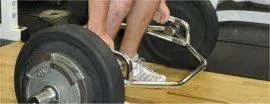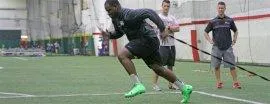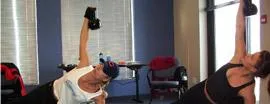Conditioning vs. Speed Training
The Debate Over Conditioning Vs. Speed Training Continues
Much confusion abounds as to the differences between conditioning vs. speed training.
Track and field coaches generally classify speed training as many short, repetitive bouts of sprinting followed by ample periods of rest to allow for full recovery.
Repeated high-intensity efforts may, in fact, be the purest form of linear speed training.
On the other hand, football or soccer coaches often believe training for speed involves performing as many high-intensity repetitions as possible in a given amount of time.
So which type of coach is truly training athletes for speed?
Recently, I had the pleasure of attending a seminar featuring one of the premiere strength coaches in the country, Joe Kenn.
As head strength and conditioning coach for the Carolina Panthers of the National Football League, Kenn routinely takes his players through 66 work sets in only 90 to 120 minutes.
That’s a lot of work in a short period of time.
Kenn has a strong case to apply this method. Because football players must operate under a fatigued state during a game, they will highly benefit from practicing with little rest between sets. While performing a high volume of repetitions in a relatively short period of time isn’t ideal for building speed, football players never perform in ideal conditions.
Nearly all athletes must learn to perform when their bodies are worn.
At my facility in Madison, WI, we train our high school athletes with a similar philosophy, although we often have access to them only once or twice per week. So, it’s important we incorporate both speed training and conditioning into each workout.
Because we deal with a wide range of athletic abilities and developmental ranges with high school athletes, we approach each individual’s plan a bit differently. We integrate speed training following a thorough warm-up and dynamic movement.
For the developmentally younger athletes, we focus on technique and practice deceleration patterns, sprint mechanics and footwork. Our developmentally older athletes work on sprinting, cutting, changing directions and building top-end speed.
Our highly developed athletes focus on reactive speed and potentially combine-based drills to prepare for a camp or tryout. All of these athletes work diligently to master the basics and fix any flaws in their movement patterns to help them remain injury-free and avoid plateaus.
Following the speed training portion of the workout, our athletes begin their strength exercises such as a squat, deadlift and Turkish get-up. Each compound movement is paired with another exercise even if it’s just low-level core work to reset an athlete’s autonomic nervous system.
If you look at time-motion studies for field- and court-sport athletes, they work intensely for brief periods of time and recover actively with low-level activity.
In a game, an athlete must always be mentally active
, so the job of a strength and conditioning coach is to prepare athletes in a way that makes a game easier than a training session. Athletes must remain active through an entire workout. After our athletes complete the strength portion of the workout, they begin their focused conditioning. Here’s where we have the most fun.
Thanks to advancements in research of the anaerobic and aerobic energy systems, we are able to be much more efficient and systematic with how we condition our athletes. Athletes play different sports and have different schedules, so we must have a broad array of conditioning sequences to address each situation.
Ultimately, we are looking to provide a bigger aerobic base for our athletes.
While we don’t want to run them into the ground all year long, we must systematically build a bigger aerobic base to develop greater potential for performance. Then, athletes are able to tap into that potential during the most important part of a season. They’ll peak while athletes from other teams feel fatigued.
So, should we run our athletes through many short, repetitive bouts with ample rest to allow for full recovery or perform repeated high-intensity efforts without much rest for best results? In short, both have a place in a strength and conditioning program. The debate will continue, though—and that’s a great thing.
If more great coaches publicize their philosophies, we will continue to advance our methods and improve the performance of our athletes. If we continue to look out for the best interests of our athletes, they will perform better than they ever thought possible.
ADAPT and Conquer,
Coach Jared
About the Author: Jared Markiewicz

Jared is founder of Functional Integrated Training (F.I.T.). F.I.T. is a performance-based training facility located in Madison, WI. They specialize in training athletes of all levels: everyday adults, competitive adults and youth ages 5-20+.
The long-term vision for F.I.T. is recognition as the training facility for those desiring to compete at the collegiate level in the state of Wisconsin. Alongside that, to also develop a platform to educate those in our industry looking to make strides towards improving the future for our young athletes.
Find out more about Jared’s gym by visiting F.I.T.
Career Highlights
2014 Fitness Entrepreneur of the Year – Fitness Business Insiders
2014 IYCA Coach of the Year Finalist
Volunteer Strength Coach for West Madison Boys Hockey and Westside Boys Lacrosse
Helped develop dozens of scholarship athletes in 3 years of business
Instructed Kinesiology Lab at UW-Madison
Houses an internship program at F.I.T. that started in 2013
Member of Elite Mastermind Group of Nationwide Fitness Business Owners

High School Strength Coach Certification

Certified Speed & Agility Specialist

Kettlebell Instructor Course

IYCA Insiders - Exclusive Access

Youth Fitness Specialist Certification

Long Term Athlete Development

Youth Nutrition Specialist Certification

Copyright © 2008 - 2025 International Youth Coaching Association. All Rights Reserved
|
|

